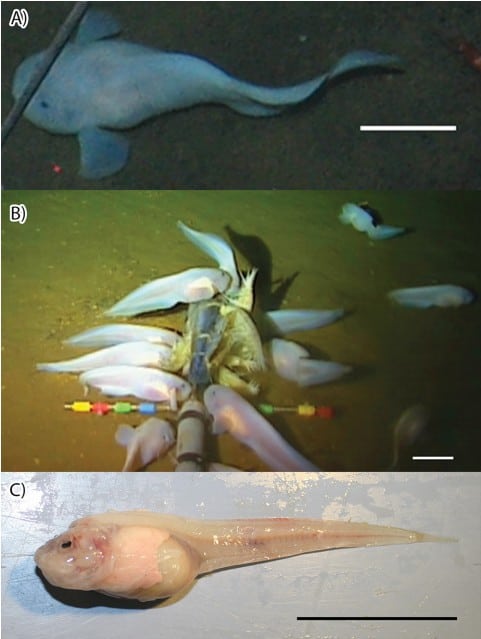The deepest ocean-dweller is a snailfish who was found over 26,700 feet below sea level.
Advertisement
Snailfish Scientific Classification
Read our Complete Guide to Classification of Animals.
Snailfish Conservation Status
Snailfish Facts
- Prey
- krill, crustaceans, fish, gammarids, natantian decapods, eat amphipods, copepods, and many more sea critters
- Fun Fact
- The deepest ocean-dweller is a snailfish who was found over 26,700 feet below sea level.
- Estimated Population Size
- unknown
- Biggest Threat
- human activity
- Most Distinctive Feature
- scaleless body and tadpole shape
- Other Name(s)
- sea snail
- Habitat
- ocean trenches, shores, hadal zone
- Diet
- Carnivore
- Common Name
- snailfish
- Special Features
- scaleless body and tadpole shape
- Number Of Species
- 410
View all of the Snailfish images!
“The deepest ocean-dweller is a snailfish who explorers found over 26,700 feet below sea level.“
Facts
- Surfaced snailfish have “melted” or “exploded” due to the drastic change in atmospheric pressure and because of the heat. This makes them difficult to study, so scientists usually defer to studying their bones instead.
- Snailfish look like tadpoles and have gelatinous bodies like snails, hence their common name. Some species even have prickly skin.
- They have adapted to living in habitats with overwhelming pressure due to genetic adaptations. Their genes protect their genome and make their bones softer.
- Snailfish don’t have swim bladders unlike many other types of fish. Instead, they produce a gelatinous substance that keeps them buoyant.
- Temperatures are freezing miles below in the deep seas, especially in the Arctic and Antarctic regions where some snailfish reside. Some species have anti-freezing proteins in their DNA sequence that keep them from freezing to death.
- These fish lay some of the biggest eggs. Their eggs measure a whopping 0.37 inches in diameter. The average fish egg measures just 0.039 inches in diameter.
- Scientists discovered the Mariana snailfish, the deepest ocean dweller on record, at a depth of 26,716 feet.
- Snailfish don’t have scales. They have loose, thin skin and tiny eyes because the bottom of the sea is extremely dark.
Summary
Snailfish are mysterious deep-sea dwellers. In fact, they are the deepest dwellers in the sea. These scaleless animals look more like tadpoles than fish and have distinctive shapes. Scientists know very little about these unique fish and they are learning more with each expedition into the deep sea.
Scientific Name
Snailfish is the common name of a family of ray-finned fish known as Liparidae. The members of this family are carnivorous, saltwater fish. They are also close relatives of the lumpsucker fish of the family Cyclopteridae. At a time, they were grouped together.
Liparidae contains around 410 species classified in over 30 genera. However, this number may be greater due to the presence of several unclassified species discovered during an expedition. These newly discovered snailfish were dubbed “ethereal” snailfish and are yet to be properly classified.
They are also grouped into the order of scorpaeniform fish, or Scorpaeniformes.
Snailfish get their name from their appearance. These creatures don’t look like fish at all. They resemble tadpoles with fins or snails without shells. Unsurprisingly, another name for the snailfish is the sea snail.
Evolution and History
When scientists were finally able to study the DNA sequence of the snailfish, a lot of information revealed itself.
Snailfish evolved from an ancestor who inhabited shallow waters some 20 million years ago. They diverged from this ancestor and gradually adapted to life in the deep sea. Snailfish evolved genetic modifications that enabled its bones to become softer and able to withstand crushing pressure.
Snailfish have extra genes that help with DNA repair. These genes function by preserving the genome of the snailfish, protecting it from mutation. These fish also evolved genes in charge of producing a chemical that stabilizes the structure of vital proteins under extreme pressure.
Unlike many other fish, snailfish don’t have swim bladders to keep them buoyant in the water. This bladder would not be useful in such habitats of intense pressure. As an alternative, they produce a gelatinous substance and special muscle enzymes that keep them buoyant. Some species of snailfish, including some members of the genus, Liparis, have type 1 antifreeze proteins that protect them from the freezing temperatures of the deep sea.
Snailfish belong to the order Scorpaeniformes, which is a large group of ray-finned fish that houses over 1,320 species. These fish are carnivorous, and their diet consists mostly of small fish and crustaceans. This is important for the snailfish whose habitat is usually teeming with more than enough food for their population. Researchers noted that the sighted snailfish looked robust and well-fed due to the abundance of food in their zones.
Appearance

Snailfish resemble tadpoles. Like snails, they lack scales and have a gelatinous body.
©Gerringer M. E., Linley T. D., Jamieson A. J., Goetze E., Drazen J. C./CCBY3.0 – License
Snailfish are named after their resemblance to snails. Just like snails, they lack scales and have a gelatinous body. Their skin is loose, thin, translucent at times, and is either smooth or prickly depending on the species. Snailfish are also shaped like tadpoles.
Snailfish have long, tapered bodies and large heads that are somewhat disproportionate to their size. They have tiny eyes, small, blunt teeth, and small tails. Additionally, they have long dorsal fins on their backs and anal fins that almost combine with the tail fin. To move around, they use their large, yet fragile, pectoral fins, which form a sucking disc below the head.
Sea snails lack swim bladders and, instead, use a gelatinous substance and muscle enzymes to keep themselves buoyant.
Snailfish species differ widely in size. Paraliparis australis measures in at only 2 inches long, while Polypera simushirae reaches 30 inches in length and weighs 24 pounds. However, most snailfish average around 12 inches long. They come in various colors, such as pink, brown, white, and blue.
Behavior
Scientists do not know much about the behavior of these deep-sea dwellers. They are so well-adapted to crushing pressure and freezing temperatures that when they rise to the surface, their bodies disintegrate due to the changes in heat and pressure. The good news is that their bones do not disintegrate, and researchers can study them.
Sea snails swim against the rapid currents on the ocean floor and float while hunting for food. When they need to rest, they use their pectoral fins with suction ability to attach themselves to stationary objects on the sea floor.
Diet
Snailfish are carnivorous animals. Their diet hinges mostly on its size and development stage. Baby snailfish in their larval stages eat many different tiny animals. They feed on copepods, amphipods, and plankton. As juvenile snailfish, their diet is categorized into 28 groups.
The adult snailfish diet includes krill, crustaceans, fish, gammarids, natantian decapods, amphipods, and many more sea critters.
Snailfish that measure about 2 inches and under mostly feed on gammarids, while those that are greater than 4 inches mainly eat natantian decapods. The sea snails that are over 6 inches in length have more fish in their diet than the others.
Habitat and Population
Snail fish are prevalent and widely distributed across the world’s oceans, from the Arctic to the Antarctic. They are cold-water fish. Even species that live in tropical and subtropical zones are very deep under the water where the temperatures are below freezing.
However, they are not deep-water fish across the board. They can occupy regions of various depths, ranging from shallow water to over 26,000 feet below sea level. For example, Liparis liparis inhabits ocean shores while other species such as some of the members of the genus Careproctus, dwell in the deep. Some species inhabit trenches in countries like Japan, Peru, and Chile.
The deepest living species ever recorded is the Pseudoliparis swirei, or the Mariana snailfish, which lives in the Mariana Trench, 26,716 feet below sea level. This dark, cold, deep-sea zone is known as the Hadal Zone and many new species of snailfish discovered here were dubbed Hadal snailfish and “ethereal” snailfish.
Most of the snailfish species are listed as Deficient Data on the IUCN Red List of Threatened Species, meaning not enough data has been collected to ascertain their population. However, some of the species are Least Concern.
Reproduction and Lifespan
There are over 400 species of snailfish, and their reproductive habits vary. However, all snailfish lay eggs that are larger than those of most other fish. The spawn size largely depends on the species of the fish in question.
Snailfish typically lay their eggs on solid surfaces including aquatic plants such as kelp, cold-water corals, and rocks. It is usually the job of the male snailfish to protect the eggs. In some species, such as Careproctus ovigerus, the males practice mouth-brooding by carrying the eggs around in their mouth.
Careproctus rhodomelas is a batch spawner and consistently lays batches of eggs throughout its reproductive life.
Some species of snailfish go for a more parasitic method of reproduction wherein they lay eggs in the gill cavities of king crabs.
Snailfish offspring grow quite fast after they hatch into larvae, reaching adulthood in a short time. Most of the time, however, they don’t live past a year. Some of them do, and can live for more than a decade.
Predators and Threats
Because of its deep-sea marine habitat, the snailfish does not have predators. In fact, it is a top predator in its location.
Ocean pollution and climate change are very real threats that could potentially harm the snailfish population. Harsh chemicals and the practice of disposing of non-biodegradable human waste such as plastics into the ocean adversely affects the flora and fauna of the environment. Also, the majority of snailfish live strictly in the freezing cold temperatures of the deep sea so climate change also has a negative impact on their habitat.
Related Animals
View all 293 animals that start with SSnailfish FAQs (Frequently Asked Questions)
Do snailfish have scales?
No, snailfish do not have scales. They have gelatinous bodies with smooth or prickly loose skin.
How many species of snailfish are there?
There are about 410 species of snailfish, but the actual number is much higher. This is because there is a slew of species that are yet to be classified.
Can I have a snailfish as a pet?
Absolutely not. Snailfish live in incredible depths thousands of feet below. There is no guarantee that they will even make it out of the ocean alive because they are known to “explode” upon contact with the surface. Also, you cannot provide the atmospheric pressure and freezing temperatures required to keep them alive and comfortable.
What do snailfish eat?
Baby snailfish in their larval stages eat many different tiny animals. They feed on copepods, amphipods, and plankton. As juvenile snailfish, their diet is categorized into 28 groups.
The adult snailfish diet comprises krill, crustaceans, fish, gammarids, natantian decapods, eat amphipods, and many more sea critters.
What eats snailfish?
Snailfish typically do not have predators. They are the top predators in their deep-sea habitat.
What Kingdom do snailfish belong to?
Snailfish belong to the kingdom, Animalia.
What phylum do snailfish belong to?
Snailfish belong to the phylum, Chordata.
What class do snailfish belong to?
Snailfish belong to the ray-finned fish class, Actinopterygii.
What order do snailfish belong to?
Snailfish belong to the order, Scorpaeniformes.
What family do snailfish belong to?
Snailfish belong to the family, Liparidae.
Thank you for reading! Have some feedback for us? Contact the AZ Animals editorial team.
Sources
- Ocean Conservancy, Available here: https://oceanconservancy.org/blog/2022/05/26/slimy-scaleless-snailfish/
- Wikipedia, Available here: https://en.wikipedia.org/wiki/Snailfish
- Wikipedia, Available here: https://en.wikipedia.org/wiki/Scorpaeniformes
- Britannica, Available here: https://www.britannica.com/animal/snailfish
















